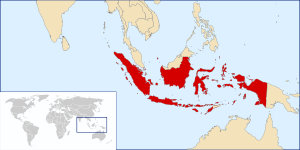Nusantara
Nusantara today is an Indonesian term for the Indonesian archipelago.[1] It originated in Old Javanese and literally means "archipelago".[2] In Malay, Nusantara bears the meaning of Malay World, and predates the modern state of Indonesia.
The word Nusantara was taken from an oath by Gajah Mada in 1336, as written on an old Javanese manuscript Pararaton and Negarakertagama.[3] Gajah Mada was a powerful military leader and prime minister of the Majapahit Empire who was credited with bringing the empire to its peak of glory. Gajah Mada delivered an oath called Sumpah Palapa, in which he vowed not to eat any food containing spices until he had conquered all of Nusantara under the glory of Majapahit.
Today, Indonesian historian believed that the concept of Nusantara was not an idea coined by Gajah Mada for the first time in 1336. It was coined earlier in 1275 as Cakravala Mandala Dvipantara by Kertanegara, king of Singhasari.[4] Dvipantara is a Sanskrit word for the "islands in between", the synonym to Nusantara as both dvipa and nusa in Sanskrit means "island". The term is used to describe the Southeast Asian Archipelago. Kertanegara envisioned the union of Southeast Asian maritime kingdoms under Singhasari against the rising of expansive Mongol Yuan Dynasty in mainland China.
Ancient concepts of Nusantara
Etymology
Nusantara is a Javanese word which appears in the Pararaton manuscript. In Javanese, Nusantara phrase meaning "outer islands" (from Old Javanese nusa, "island" and antara, "within"). Based on the Majapahit concept of state, the monarch had the power over three areas:
- Negara Agung, or the Grand State, the core kingdom. This includes the capital and the surrounding area. In the context of the Majapahit empire, this area covered East Java and its surrounding area.
- Mancanegara, areas surrounding Negara Agung. These areas are directly influenced by Javanese culture. In the context of Majapahit empire, this includes the entire Java island, Madura, Bali, as well as Lampung and Palembang in South Sumatra.
- Nusantara, areas which do not reflect Javanese culture, but are colonies where they had to pay tribute. In the context of Majapahit empire, this includes the modern territories of Indonesia, Malaysia, Singapore, the Philippines, Brunei, East Timor and southern Thailand.
The first appearance of Nusantara concept in the 20th century

In 1920, Ernest Francois Eugene Douwes Dekker (1879–1950), who was also known as Setiabudi introduced a name for his country (Indonesia) which didn't contain any words etymologically inherited from any Indian languages.[5] This is the first instance of the term Nusantara appearing after it had been written into pararaton manuscript.
The definition of Nusantara introduced by Setiabudi is different to the 14th century definition of the term. During the Majapahit era, Nusantara described vassal areas to be conquered. Setiabudi didn't want this aggressive connotation, so he defined Nusantara as all the Indonesian regions from Sabang as far as Merauke.
Palapa Oath (where the term Nusantara was first used) is in reality the embryo of the modern unitary state of the Republic of Indonesia, notwithstanding the fact that the territory of Majapahit was then even much wider than the current territory of Indonesia.[6]
Modern usage
Today in Indonesian, Nusantara is synonymous with Indonesian archipelago or the national territory of Indonesia, in this sense the term Nusantara excludes Malaysia, Singapore, Brunei and the Philippines. While in Malaysian this term is synonymous and often interchangeable with Malay archipelago or Malay realm (Malay: Alam Melayu) which includes those countries, and the Philippines.
Nusantara studies
The Nusantara Society in Moscow conducts studies on the Nusantara region's history, culture, languages and politics.
See also
References
- ↑ Echols, John M.; Shadily, Hassan (1989), Kamus Indonesia Inggris (An Indonesian-English Dictionary) (6th edition ed.), Jakarta: Gramedia, ISBN 979-403-756-7
- ↑ Friend, T. (2003). Indonesian Destinies. Harvard University Press. p. 601. ISBN 0-674-01137-6.
- ↑ Prapanca, Mpu; Robson, S. O.; Owen, Stuart (1995), Nagarakrtagama by Mpu Prapanca ; translated by Stuart Robson, Leiden: KITLV, ISBN 90-6718-094-7
- ↑ Indonesia Negara Maritim (in Indonesian)
- ↑ Vlekke, Bernard H.M. (1943), Nusantara: A History of the East Indian Archipelago (1st ed.), Netherlands: Ayer Co Pub, pp. 303–470, ISBN 978-0-405-09776-8
- ↑ Rachmananta, Dady P. "UNESCO: Pararaton Manuscript (MEMORY OF THE WORLD REGISTER)", Unesco, Jakarta, June 18, 2004
External links
- WACANA NUSANTARA
- UNESCO: Pararaton Manuscript (MEMORY OF THE WORLD REGISTER)
- Gajah Mada article
- Nusantara as exposed by setiabudi
| |||||||||||||||||||||||||||||||||||||||||||||
